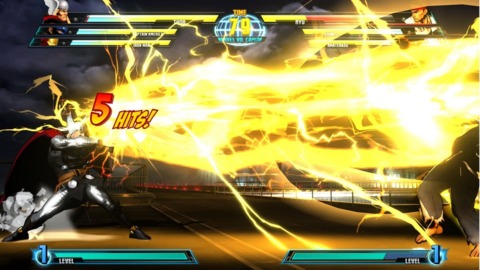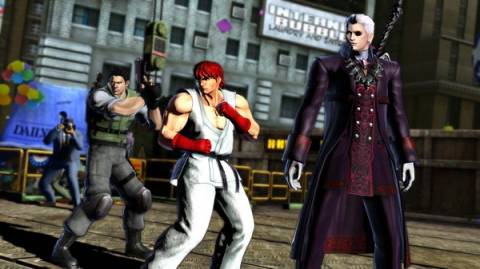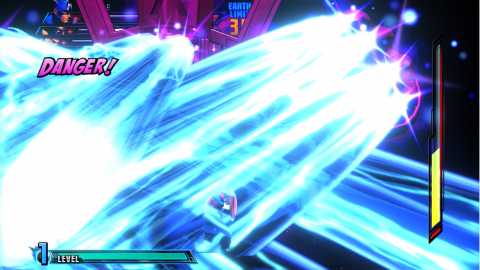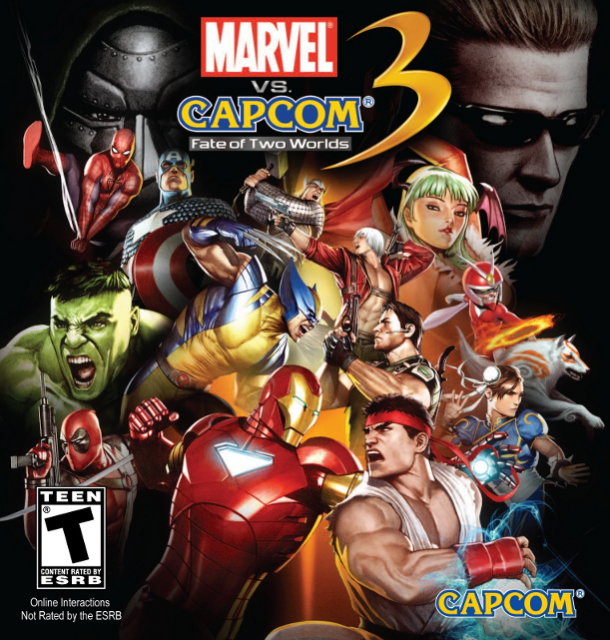A Geeky Spectacle of Sight and Sound!
When I first laid eyes on Street Fighter IV, Capcom's big push to resurrect the skill-based and strategic two-dimensional fighting franchise, I was enthralled. It was as simple to play as Street Fighter had ever been in the past eight years or so, but it kept the best aspects of the Street Fighter 2 iterations and the Alpha series - yes, there was still more than one bar you needed to read, as there were ultra moves, but the whole thing just felt more like an improvement on the original SF2, or maybe its Turbo cousin.
The first thing I thought of, being a Marvel vs. Capcom 2 junkie back in the Dreamcast days, was "Wouldn't it be cool if this graphics engine was used to make a Marvel vs. Capcom game?" Yup. Here it is.
Visuals

I was impressed by MvsC3's visual style from the first time I saw screenshots of the game. The characters are just drawing-ish enough to distinguish their designs from the Street Fighter IV series, but it's not overly gimmicky. It doesn't look like that somewhat antiquated term in graphics-speak - "cel-shaded." It's just the right combination to keep everything looking sharp. Special moves are laden with detailed effects and just as over-the-top as you remember from MvC2, if not more so. Try not to smile the first time you witness Iron Man's Proton Cannon move. I dare you.
The backgrounds, to me, are the centerpiece of this game. Capcom's fan service didn't end with the characters; stages brim with little details from some of your favorite comic franchises and video games. My favorite is the Ghosts n' Goblins level: seeing all of those old-school baddies as you float along the level will either bring back warm, nostalgic memories or jarring, traumatic nightmares about your first NES Ghosts n' Goblins playthrough. The Final Fight-themed stage has a bunch of the baddies that you've been so accustomed to punching in the face, including Poison. Asgard comes with its own unicorn and giant phoenix-looking thing (and if I read Thor, maybe I'd know a bit more of what's going on there). The final boss stage is nice; even though you're all a bunch of knowledgeable gamers that probably already know about the final battle from the Quick Look, I don't want to spoil much here. It's great, if a bit generic-spacey, but if you lose, prepare for some planet-crushing awesomeness.
Sound
This is the giant, mechanized elephant in the room that many reviewers are completely overlooking. Being a music geek, I need to comment on the sound here. It's excellent, and it's an interesting take on how soundtracks should work. The default setting for the soundtrack makes it so there isn't a background track for each stage; it's a background track for each character. That's huge. That means you'll sometimes hear the Bionic Commando theme when Spencer is on the playing field, or the 1st stage theme from Ghosts n' Goblins when Arthur is out. Yes, there's even a full-blown remix of the DMC4 metal track when Dante's fighting. I'm not sure of the logic at work here; the track definitely plays through, even if a character switches out, but I'm pretty sure it changes if that character dies. You'll get to hear more than one song per fight most of the time, and it's a welcome bit of variety - it makes fighting within the same stage a bit less monotonous than usual.
There's also a completely different soundtrack - go into the "Sound" options, and set the music to "Dynamic." You'll get a more orchestral background. Overall, the dynamic soundtrack sounds a bit cliched and 2010 trailer-ish, but it's a nice way to change things up. On this mode, you'll typically just have one track per stage.

Voices are well done for the most part. Some of the English voice acting for Japanese characters comes across as just weird, since I'm so used to hearing their voices in Japanese. Ever hear Ryu speak English? It's a bit jarring, even if the voice acting is decent. Luckily, options include changing certain characters' voices to either English or Japanese; it's not an all-or-nothing decision, which is much appreciated. I want Akuma speaking Japanese and Deadpool speaking English, and Capcom acknowledged that. Well played, Capcom.
There's also an optional voice commentary setting in the options menu. I'd recommend keeping that off; it's off in the default settings for a reason. The annoying (in a so-bad-it's-boring way) voice is always hidden behind the over-the-top sound effects and music anyway, so it's better off just not being there.
Sound effects are just as loud and crazy as ever. Traditional Japanese instruments step in for a flourish when Amaterasu calls down the elements on dudes, explosion sounds are as boomy as they need to be; it's a loud game, and the effects really fit the overall tone.
Gameplay/Controls
I'm not the person to ask about the control system or balancing, to tell you the truth. I'm a gamer who loves to play fighting games, enjoys a bit of online stuff, loves on-the-couch versus play, but mainly goes single-player. I'm never, ever, ever going to win a tournament at Evo, so don't ask me about the finer points of air combos.
That said, I find the control scheme extremely enjoyable. Gone are the punch-kick separations from most previous franchises; in their place is a BlazBlue-esque light/medium/heavy attack scheme with a "Special" (aka "Knockin' Dudes in the Air") button. Because the controls are a bit simpler, and moves are often uniform (there are hardly any "charge" moves left), the game quickly turns strategic for mid-level and pro fighters alike. Because I didn't have the time, energy, and stereotypical basement to dwell in to memorize every move in MvsC2, I was constantly just figuring things out and trying my best to throw some stuff out there during fights. In this game, I pretty much know how to control each character, meaning that I'm already seeing the other team and going "Okay, this guy's a projectile-oriented one; maybe if I use a quick slasher-type character I'll catch him off guard..." For me, that's excellent.
What that means for veterans is that the old characters won't have all their old moves. For example, I loved Iron Man's heavy sweep kick in MvsC2, and that's pretty much gone. I find myself trying to sweep an opponent, only to slowly shoot a rocket instead. That's something that I've gotta get over, and it's something that more seasoned MvsC2 vets will have an even tougher time un-learning also.
Overall

Postscript: DLC Madness
There has been quite a bit of argument that Capcom is milking gamers for all they're worth with content in MvsC3. The character count is lower, of course, and some of the DLC is rumored to already be on the disc. While I miss unlocking so many characters, I'm also appreciative of a few things here:
- Each character can fight. There's no 'gimmick' character that's just there for laughs, every character is capable of beating another character, so long as you know how to use him or her.
- Most characters are available from the start. This is great since many gamers picked up the game and immediately wanted to play it with friends; sitting there and unlocking all the characters would seem like a pointless exercise in that context, and Capcom rightly kept the unlockable characters count limited.
- There is definitely 60 dollars worth of content within the retail release. When you look at the work that's been put into the sound design, the backgrounds, the characters, the voice acting, and the new gameplay system, the amount of detail is mind-bogglingly immense. This isn't a day-one purchase you'd regret.
- DLC will hopefully not mimic Resident Evil 5. I don't think we're going to have to pay for some paltry gimmick "Versus Mode" here; even though costume purchases are a bit silly in my eyes, unlockable characters are totally fine. I'll buy DLC for this game to make it even more enjoyable later on, and to support one heck of an effort from Capcom to bring this franchise back. It's like buying the swag for your favorite TV series, movie, or game; if you love it, support its creators. If you hate it, don't support it.
There, enough soapboxing. If you ever loved fighting games at any point in your life, go buy this game!
